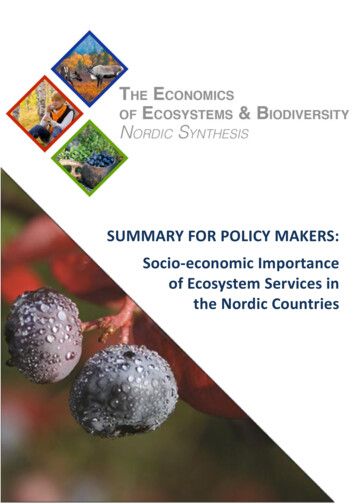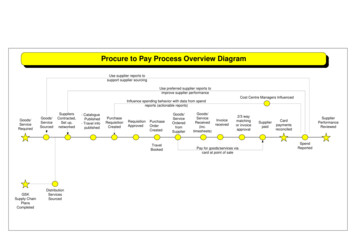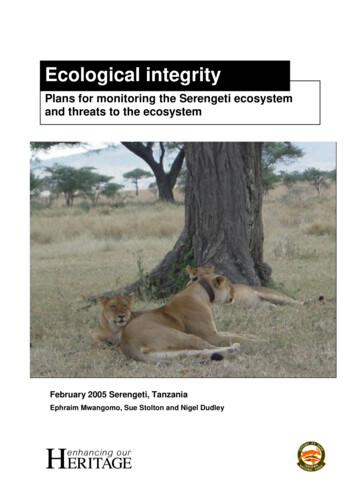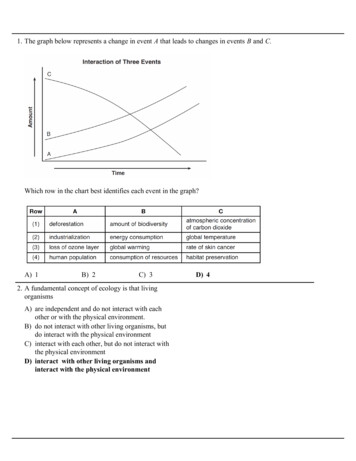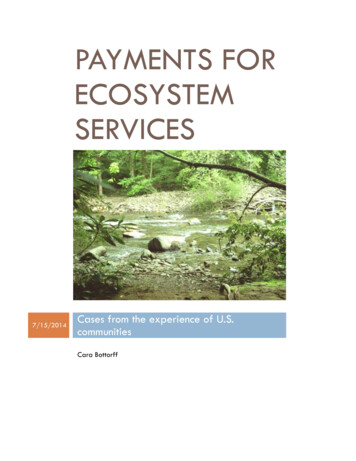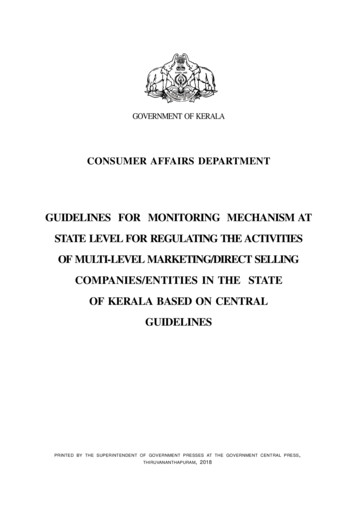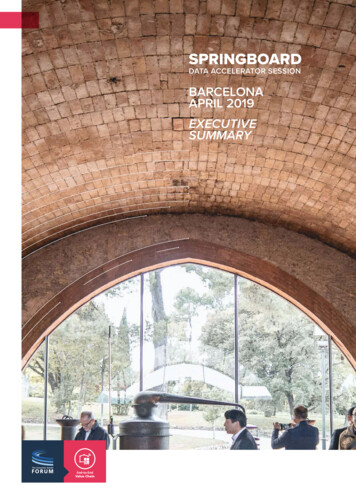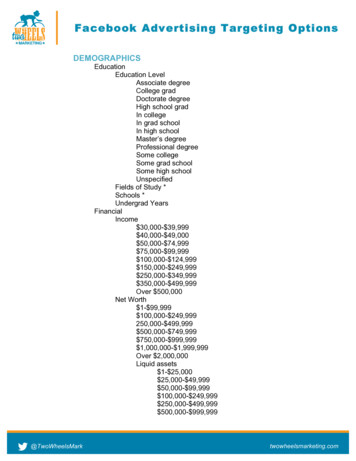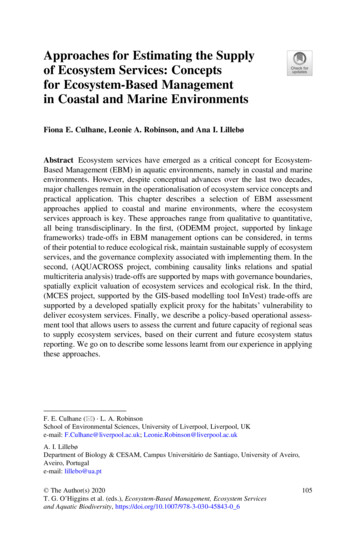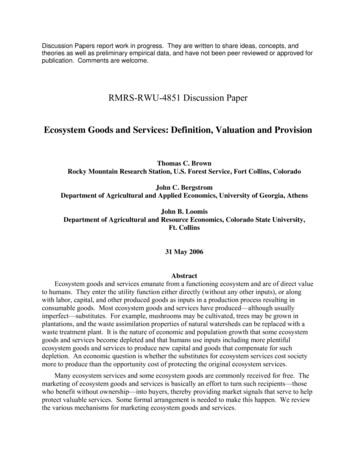
Transcription
Discussion Papers report work in progress. They are written to share ideas, concepts, andtheories as well as preliminary empirical data, and have not been peer reviewed or approved forpublication. Comments are welcome.RMRS-RWU-4851 Discussion PaperEcosystem Goods and Services: Definition, Valuation and ProvisionThomas C. BrownRocky Mountain Research Station, U.S. Forest Service, Fort Collins, ColoradoJohn C. BergstromDepartment of Agricultural and Applied Economics, University of Georgia, AthensJohn B. LoomisDepartment of Agricultural and Resource Economics, Colorado State University,Ft. Collins31 May 2006AbstractEcosystem goods and services emanate from a functioning ecosystem and are of direct valueto humans. They enter the utility function either directly (without any other inputs), or alongwith labor, capital, and other produced goods as inputs in a production process resulting inconsumable goods. Most ecosystem goods and services have produced—although usuallyimperfect—substitutes. For example, mushrooms may be cultivated, trees may be grown inplantations, and the waste assimilation properties of natural watersheds can be replaced with awaste treatment plant. It is the nature of economic and population growth that some ecosystemgoods and services become depleted and that humans use inputs including more plentifulecosystem goods and services to produce new capital and goods that compensate for suchdepletion. An economic question is whether the substitutes for ecosystem services cost societymore to produce than the opportunity cost of protecting the original ecosystem services.Many ecosystem services and some ecosystem goods are commonly received for free. Themarketing of ecosystem goods and services is basically an effort to turn such recipients—thosewho benefit without ownership—into buyers, thereby providing market signals that serve to helpprotect valuable services. Some formal arrangement is needed to make this happen. We reviewthe various mechanisms for marketing ecosystem goods and services.
5/31/06Ecosystem Goods and Services2Table of ContentsIntroduction. 3What Is an Ecosystem Service? . 3Ecosystem Goods and Services Within an Economic Context. 5General Background from Economic Growth Theory. 6Ecosystem Good or Service Value Concepts. 8Substitute Relationships. 9Valuation of Ecosystem Services. 10Role of Economic Valuation. 10Dimensions of Economic Value . 11Graphical Illustrations of Economic Values of Ecosystem Goods and Services. 12Methods for Valuing Ecosystem Goods and Services. 13Providing and Financing Ecosystem Goods and Services. 16Conditions of Exchange. 17Characteristics of Ecosystem Goods and Services and Economic Efficiency. 21Mechanisms of Exchange . 23Likelihood of Market Exchange . 30Conclusions. 32References. 33Tables. 36Figures. 44Appendix. Implications and Issues for Public Land Management . 47
5/31/06Ecosystem Goods and Services3Ecosystem Goods and Services: Definition, Valuation and ProvisionIntroduction“Ecosystem service” is the latest environmental buzzword (Boyd and Banzhaf, 2005). Itappeals to ecologists, who have long recognized the many benefits of well-functioningecosystems, and who are pleased that others are taking notice. It appeals to resource economists,who have labored to measure the value to humans of natural resources. And it appeals to a hostof others—public land managers and many private landholders included—who see opportunitiesfor more efficient and effective provision of basic environmental service flows. With all of thisinterest, “ecosystem service” has quickly come to represent several related topics, four of whichare (1) the measurement of ecosystem service flows and the processes underlying those flows,(2) understanding the effect of those flows on human well-being, (3) valuation of the services,and (4) provision of the services. We begin by explaining what “ecosystem service” means andhow it fits within an economic context, emphasizing the fundamental contribution of ecosystemgoods and services in human wellbeing, but also noting the importance of substitutes. Next wereview valuation of ecosystem goods and services. Then we discuss provision and financingmechanisms for ecosystem goods and services, focusing on the conditions that facilitate marketexchange and on the various mechanisms that are now used to provide and protect the goods andservices.What Is an Ecosystem Service?In the introduction to a book she edited on ecosystem services, Gretchen Daily answered thequestion posed in this section in the following way:Ecosystem services are the conditions and processes through which naturalecosystems, and the species which make them up, sustain and fulfill human life.They maintain biodiversity and the production of ecosystem goods, such as seafood,forage, timber, biomass fuels, natural fiber, and many pharmaceuticals, industrialproducts, and their precursors. In addition to the production of goods, ecosystemservices are the actual life-support functions, such as cleansing, recycling, andrenewal, and they confer many intangible aesthetic and cultural benefits as well(Daily, 1997, p. 3).Daily’s definition makes an important distinction, between ecosystem services andecosystem goods. Ecosystems goods are the generally tangible, material products that resultfrom ecosystem processes, whereas ecosystem services are in most cases improvements in thecondition or location of things of value.1 Daily explains that ecosystem services are generated bya “complex of natural cycles,” from large scale biogeochemical cycles (such as the movement ofcarbon through the living and physical environment) to the very small scale life cycles of1Like most dichotomies—and the reader will encounter several in the course of this paper—the distinction betweengoods and services is not without exceptions or complications. For example, recreation opportunities do not fitneatly into either category, as they are neither tangible items (as are water, trees, and copper) nor improvements inconditions (as are water purification, flood mitigation, and pollination). We classify recreation opportunities asgoods, based primarily on the fact that an opportunity is not an improvement in the condition of anything. Of course,taking advantage of the opportunity may improve the condition of the participant, but that is another issue.
5/31/06Ecosystem Goods and Services4microorganisms. Such cycles are “the product of billions of years of evolution, and have existedin forms very similar to those seen today for at least hundreds of millions of years” (p. 5)Daily lists several ecosystem services, such as purification of water, mitigation of floods,and pollination of plants. As she mentions, these services “are absolutely pervasive, butunnoticed by most human beings going about their daily lives” (p. 5). Unlike these ecosystemservices, most ecosystem goods do not go unnoticed, as they are the basic natural resources thatwe consume on a regular basis. Ecosystem goods had long been recognized as key elements ofwealth; it is the grand contribution of the modern ecological and hydrological science to morefully recognize and appreciate the services that nature also provides.The tidy distinction between ecosystem services and ecosystem goods was later obscured byCostanza et al. (1997), who, after noting the difference between goods and services, proceeded tolump them into the class of “ecosystem services.” This lumping had the advantage of brevity buttended to blur the distinction between the functional nature of ecosystem services and theconcrete nature of ecosystem goods. This lumping was adopted by others, including De Groot etal. (2002), the Millennium Ecosystem Assessment (Alcamo et al., 2003), and the NationalResearch Council’s Committee on Assessing and Valuing the Services of Aquatic and RelatedTerrestrial Ecosystems (Heal et al., 2005). We will maintain the distinction between goods andservices.Daily’s (1997) definition makes another key point about ecosystem services: they “sustainand fulfill human life.” The emphasis here is squarely on human well-being, and thus in keepingwith an economic perspective. Some might say that such an anthropocentric focus is toolimiting—that it devalues the importance of ecosystem structure and processes to species otherthan humans, or that it runs the risk of ignoring ecosystem processes that contribute to humanwelfare but are not yet recognized as doing so. Clearly a focus on ecosystem services may turnout, through hubris or ignorance, to have been short-sighted, but, on the other hand, this focus isa vast improvement over business as usual and an opening for even greater consideration ofecosystem services as our understanding of the natural world improves.Where we differ with Daily’s definition is that we, as have others (e.g., Boyd and Banzhaf,2005; Costanza et al., 1997; de Groot et al., 2002), draw a distinction between ecosystemservices and ecosystem processes. Ecosystem processes (also sometimes called functions) arethe complex physical and biological cycles and interactions that underlie what we observe as thenatural world. Ecosystem services are the specific results of those processes that either directlysustain or enhance human life (as does natural protection from the sun’s harmful UV rays) ormaintain the quality of ecosystem goods (as water purification maintains the quality ofstreamflow). For example, the forces of wind and water, made possible by solar energy andgravity, produce the service we call “translocation of nutrients.” Similarly, microorganisms inthe soil and stream, seeking their own life-preserving conditions, remove contaminants fromwater, producing the service “water purification”.Although the difference between processes and services is more than semantic, it may notalways seem so, especially when the terms used to summarize the processes are only slightlydifferent from the terms used to characterize the service. For example, the function in whichwater infiltrates into watershed soils, is stored in those soils, and is later released downstream,which has been called “regulation of hydrologic flows,” produces the service called “water
5/31/06Ecosystem Goods and Services5regulation” (Costanza et al., 1997). The shorthand labels we attach to processes and servicesmust not be allowed to blur the distinction between processes and the services they perform.Table 1 lists ecosystem goods and services. Ecosystem goods are grouped in two broadcategories: renewable and nonrenewable. The nonrenewable ecosystem goods can only be usedup, although recycling allows for some recapture and reuse. Renewable ecosystem goods can bereceived in perpetuity if the stock is managed in a sustained yield fashion (i.e., harvest equalsgrowth). Of course, a stock of renewable resources can be used at a rate faster than its naturalgrowth or replenishment rate. In the limit, the entire stock of some renewable resource, such as atimber stand or fish population, could be converted to an ecosystem good and consumed in oneperiod.The ecosystem services of Table 1 are similar to those listed by Daily (1997), with someadditions and deletions. They result from an assortment of very complex, sometimes interactingphysical and biological processes, touching many aspects of human life, including the air webreathe, the water we drink, our food, the weather, our health, and our outdoor recreationpossibilities.We define ecosystem goods and services generally as the flows from an ecosystem that areof relatively immediate benefit to humans and occur naturally.2 As shown in Figure 1,ecosystem goods and services result specifically from ecosystem structure and processes.Ecosystem structure refers to the abiotic and biotic components of an ecosystem and theecological connections between these components. Ecosystem process refers to the cycles andinteractions among those abiotic and biotic components, which produce ecosystem goods andservices. The feedbacks in Figure 1 represent both the negative impacts of human actions on theecosystem and human efforts to protect the ecosystem. The ways in which ecosystem structureand processes generate ecosystem services (e.g., the natural production or transformationfunctions) are primarily ecologists’ and other physical scientists’ area of interest and expertise.The values and provision of ecosystem goods and services that enter directly into consumers’utility functions and also indirectly as inputs into economic production are primarily economists’area of interest and expertise, and the focus of the following sections of this paper.As a final point of clarification, we note that the goods and services of Table 1 derive frommore than just the “ecosystem.” Indeed, they include nonrenewable resources that accumulatedthrough geologic processes that took millions of years, as well as services that involve globalhydrologic and climatic systems. Herein we will continue with the convention of referring to allof these as “ecosystem” goods and services.Ecosystem Goods and Services within an Economic ContextThe focus of the modern discussion of ecosystem goods and services is on recognizing thebenefits that humans derive from a well-functioning ecosystem. Thus, it is fitting to explain howecosystem goods and services fit within an economic theory framework.2Not all taxonomies of ecosystem services limit them to naturally-occurring goods and services. For example,among its set of ecosystem services the Millennium Ecosystem Assessment (Alcamo et al., 2003) includes producedcommodities such as agricultural products. We limit “ecosystem services” to naturally-occurring goods and services;that is, services that exist without human action.
5/31/06Ecosystem Goods and Services6General Background from Economic Growth TheoryWe begin by going back to the aggregate (macroeconomic) production function or growthmodel for an economy as conceptualized by classical economists:Y f ( M , L, K )(1)where Y is the total amount of goods and services (i.e., things of relatively direct utility tohumans) produced in an economy, and M, L, and K are the total amounts of land, labor andcapital available in an economy, respectively.Capital (K) refers to produced means of production, such as buildings, tools, roads, andvehicles. The meaning of capital within this framework has changed little over the years, but themeanings of land and labor have changed considerably. To classical economists such as AdamSmith and Thomas Malthus, “land” in equation (1) was the pivotal if not primary factor ofproduction.3 Although land was recognized by most classical economists as including the entirenatural world of land, sea, and atmosphere, agriculture and its land inputs were generally theprimary focus (Hubacek and van der Bergh, 2006). The surplus from the land was seen as theinitial and most essential source of wealth, making all other production—and the industrialrevolution—possible. However, by the time of the neoclassical school, in the early 20th century,land had lost much of its cache, coming to be considered as just a factor of production, withoutspecial characteristics and generally substitutable with other factors.4 Such de-emphasis of land,plus a general lack of interest in externalities, set the stage for the rise of environmentaleconomics in the 1960s and 1970s with works by such economists as Boulding (1966),Georgescu-Roegen (1971), Kneese (1979), and Krutilla and Fisher (1975). These economistsformally recognized the importance and uniqueness of natural resources in economic productionand growth.The modern emphasis on natural resources initially focused on resource stocks, bothrenewable and nonrenewable. Since the early 1990s the stock of natural resources important foreconomic production and growth has been referred to as “natural capital” (Daly, 1994; Ayres,1996). This new term encompasses the earth’s surface, its species, the nonliving material stocksof the earth’s crust and atmosphere from which input flows are extracted and into which wasteprojects get discharged, and even the sun, the source of solar radiation (England, 2000).“Natural capital” returns us to the classical understanding of land, but with an even richerappreciation of its many different components, as scientific discovery has expanded ourknowledge of the natural world.The classical notion of “labor” has also been reinvigorated. Like land, “labor” had graduallylost whatever complexity it had once embodied, succumbing to the logic of substitutability.Recently the meaning of “labor” has been explicitly broadened to include both the knowledgethat labor brings to the production process and the institutional and social networks (e.g., laws,educational systems, practices of child upbringing) that underlie the formation of a trained laborforce. It is now common to refer to labor and the familial and institutional processes that support3David Ricardo and Karl Marx were exceptions, for whom labor was considered the primary source of wealth.By the middle of the 20th century, land for some economists had essentially disappeared from the productionfunction. Solow (1956, p. 67), or example, used a production of the form Y f(K,L), stating “the productionfunction is homogenous of first degree. This amounts to assuming no scarce nonagumentable resource likeland.” (as quoted by England, 2000).4
5/31/06Ecosystem Goods and Services7it as “human capital”. Incorporating these new, more comprehensive concepts into the originalaggregate production function we have:Y f ( N, H , K )(2)where N and H refer to natural and human capital, respectively, while K continues to refer tobuilt capital. This new formulation recognizes the importance of the processes underlying inputsof immediate concern (i.e., natural resources and labor) in production of goods and services.Recently economists and ecologists have turned their attention to the flows of goods andservices that emanate from the stocks of natural resources. In contemporary terminology, asstated earlier, these natural resource flows, that from a utilitarian perspective are valuable topeople in economic production and consumption, are referred to as ecosystem goods andservices.From an economic theory perspective, ecosystem processes are akin to a production functionsuch as equation 1. That is, ecosystem processes can be thought of as natural production ortransformation functions, specified in general form as:E j r (N H )(3)where Ej refers to the jth ecosystem good or service, N represents natural capital and r( ) is thenatural production or transformation function (i.e., ecosystem process). Of course, ecosystemgoods and services flow from natural capital without inputs of labor or build capital. However,in our modern world, ecosystems must consciously be left to perform their functions. Making Nconditional on H in equation 3 indicates that in today’s complex world ecosystem processes areoften damaged by human endeavors and are left to do their work relatively unimpeded by humanenterprise only through conscious decisions to protect the ecosystem (Figure 1).An example of an ecosystem good is natural instream flow. Following equation 3, naturalinstream flow is a function of N, as in:Natural instream flow r ( precipitation, terrain, soils, aquifers, biota)(4)That is, natural instream flow is derived from natural capital in the form of precipitation, terrain,soils, aquifers, and biota (plants and animals) found in the ecosystem. The function r( ) inequation 4 represents the ecological and hydrologic processes that produce or generate naturalinstream flow in a particular watershed.5In a similar vein, human labor for a particular production process can be thought of asflowing from human capital. Like ecosystems, human systems have structure and processes. It isthrough the structure and processes of human systems that the labor force is created. Thus, wemay think of labor as emanating from human capital (H) along with ecosystem goods andservices and produced capital inputs, as:L j h(E, H, K )5(5)Nonrenewable ecosystem goods, such as gold or oil, are a special case. Here the ecosystem functions of interestplayed their roles over thousands or millions of years past, operating in cycles that take so long relative to our lifespans that we think of the goods as nonrenewable.
5/31/06Ecosystem Goods and Services8where Lj refers to the jth unit of labor and K is taken to include not only prior produced capital(fixed) factors of production but also an array of produced goods and services that serve asvariable factors of production, both subject to depreciation.Produced capital (K) is produced using land, labor, and other capital goods in a productionprocess f:K j f (E, L, K )(6)where K is as defined for equation 5.Thus, within the modern economic framework, goods and services are derived fromcombinations of ecosystem goods and services, labor, and capital according to a microeconomicproduction function:Q j q(E, L, K )(7)where Qj is a good or service of direct utility to humans produced by an individual or firm, q( ) isa production process, E indicates an array of ecosystem goods and services, L indicates an arrayof labor inputs, and K is as defined above. For example, if Q is potatoes E could signify soil andwater plus such services as renewal of soil fertility and pollination, L is the farmer’s knowledgeand labor, and K indicates the farmer’s tools as well as seeds and pesticides.Thus each of the components of the production of final goods and services (i.e., E, L, andK) is the result of production functions and underlying processes of their own: E results fromecological production functions, L results from human production functions, and K results fromeconomic production functions.Ecosystem Good or Service Value ConceptsEcosystem goods and services, like the other factors of production, are of value to humansbecause they enter the utility function. We define individual i’s utility function generally as:U i u E1 ,Q ( E2 , L, K ) (8)E1 stands for those ecosystem goods and services that enter the utility function without any otherinputs. Examples include the air that we breathe, natural temperatures, UV protection, and alandscape view. E2 represents an array of ecosystem goods and services requiring other inputs(i.e., elements of L, and K) for consumption, varying from those that enter the utility functionwith little in the way of other inputs to those that require large amounts of other inputs.6Ecosystem goods requiring small amounts of labor and capital include such things as instreamflow for drinking by a hiker and wild mushrooms ready for picking. Only travel to and from thesite and minimal harvest effort are needed to enjoy such goods. Examples of ecosystem goodsthat require much more labor or capital are timber, which must be cut, hauled, and milled beforeit becomes lumber, and crude oil, which must be pumped, transported, and refined before itbecomes gasoline.6The dichotomy between E1 and E2 is somewhat artificial, in that there is a continuum from those ecosystem goodsand services that require little or no other inputs to be of direct utility to humans to those that require a great deal.
5/31/06Ecosystem Goods and Services9All of the ecosystem services of Table 1 contribute to the maintenance or quality of one ormore of the renewable ecosystem goods of the table. For example, purification of air maintainsair quality, pollination and seed dispersal assist the propagation of wild plants, and maintenanceof precipitation patterns assists water supply as well as natural plant and animal survival. Inaddition, several of the ecosystem services, especially the bottom six on the list, can directlyaffect utility. For example, moderation of temperature extremes, protection from harmful UVrays, and natural pest control all directly enter the utility function.To further explain, to produce a drink of water while on a hike we directly use the instreamflow, not the natural production or transformation functions (e.g., ecosystem processes) thatproduce the flow. Similarly, to produce a fishing trip an angler combines a recreationopportunity (including instream flow and a fish population), labor (e.g., effort, fishing skills) andbuilt capital (e.g., boat, fishing gear) to produce a fishing experience. However, in these caseswhere the ecosystem service is not directly consumed, there is a derived demand for theecosystem service, and thus for the processes and the natural capital (e.g., ecosystem structure)supporting ecosystem processes, as seen by showing equation 3 within equation 8:U u E1 r ( N ) ,Q ( E2 r ( N ) , L, K ) (9)The ecosystem good that does enter the utility function is the result of the natural productionfunction as specified in equation 3. The essential point here is that ecosystem goods and servicesare the components of the natural world that enter our utility function either directly, or indirectlyas inputs in the production of final goods and services.The various pathways by which ecosystem goods and services affect utility are depicted inFigure 2. Ecosystem services can directly affect utility (pathway 1), maintain the quality ofecosystem goods (2), or be used in the production of manufactured or agricultural goods (3).Examples of (1) include protection from harmful UV rays, and maintenance of air quality.Examples of (3) include pollination of agricultural crops and protection of the quality ofstreamflow that is diverted, treated, and delivered for human use. Renewable ecosystem goodscan affect utility directly (4) or act as inputs in the production of goods (5) that then directlyaffect utility (8). Examples of such ecosystem goods include a beautiful landscape view andtimber, respectively. Nonrenewable ecosystem goods, such as oil, serve as inputs in theproduction of produced goods (6). Built capital and labor are also used in the production ofproduced goods (7).Substitute RelationshipsThe relative quantities of E, L, and K that are required to produce a good or service Q are tosome extent substitutable. To take farming as an example, a farmer may substitute K (in theform of tractors and combines) for L (human labor). Most ecosystem goods and services havesubstitutes in the form K and Q. For example, considering ecosystem goods, wild mushroomsmay be cultivated, and timber for wooden studs may be replaced with iron for metal studs (seethe right-hand column of Table 2). Or, considering ecosystem services, the waste assimilationproperties of natural watersheds can be replaced with a waste treatment plant (a form of K), andnatural pest control can be replaced by pesticides (a form of Q). Of course, all of these producedsubstitutes require inputs including other forms of E, but this does not negate the fact thatsubstitutes generally exist.
5/31/06Ecosystem Goods and Services10It is the nature of economic and population growth that some ecosystem goods and servicesbecome depleted and that humans use their technological prowess along with inputs includingmore plentiful ecosystem goods and services to produce new capital and goods that compensatefor such depletion. Of particular interest is whether the cost of producing substitutes for Eexceeds the opportunity cost of protecting the original forms of E. For example, healthywatersheds control the amount of sediment that enters streams during precipitation events,keeping the cost of water treatment and delivery down (as well as protecting aquatic habitat).Healthy streams also perform natural waste assimilation, again containing the cost ofdownstream water treatment (and protecting aquatic life). The recent focus on ecosystemservices has been in large part an effort to bring attention to the economic importance of naturalecosystems and the fact that when ecosystems are degraded, the services lost must often bereplaced with costly substitute investments of human and built capital (de Groot et al., 2002;Loucks and Gorman, 2004).7Valuation of Ecosystem ServicesT
services are the actual life-support functions, such as cleansing, recycling, and renewal, and they confer many intangible aesthetic and cultural benefits as well (Daily, 1997, p. 3). Daily's definition makes an important distinction, between ecosystem services and ecosystem goods.
